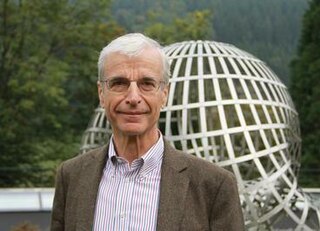André Weil was a French mathematician, known for his foundational work in number theory and algebraic geometry. He was one of the most influential mathematicians of the twentieth century. His influence is due both to his original contributions to a remarkably broad spectrum of mathematical theories, and to the mark he left on mathematical practice and style, through some of his own works as well as through the Bourbaki group, of which he was one of the principal founders.

In mathematics, specifically in the field of finite group theory, the Sylow theorems are a collection of theorems named after the Norwegian mathematician Peter Ludwig Sylow that give detailed information about the number of subgroups of fixed order that a given finite group contains. The Sylow theorems form a fundamental part of finite group theory and have very important applications in the classification of finite simple groups.

Jacques Tits was a Belgian-born French mathematician who worked on group theory and incidence geometry. He introduced Tits buildings, the Tits alternative, the Tits group, and the Tits metric.
In mathematics, computational group theory is the study of groups by means of computers. It is concerned with designing and analysing algorithms and data structures to compute information about groups. The subject has attracted interest because for many interesting groups (including most of the sporadic groups) it is impractical to perform calculations by hand.

Geometric group theory is an area in mathematics devoted to the study of finitely generated groups via exploring the connections between algebraic properties of such groups and topological and geometric properties of spaces on which these groups act.

Ian Grant Macdonald is a British mathematician known for his contributions to symmetric functions, special functions, Lie algebra theory and other aspects of algebra, algebraic combinatorics, and combinatorics.

Michael Jerome Hopkins is an American mathematician known for work in algebraic topology.

Jiří (Jirka) Matoušek was a Czech mathematician working in computational geometry and algebraic topology. He was a professor at Charles University in Prague and the author of several textbooks and research monographs.
János Kollár is a Hungarian mathematician, specializing in algebraic geometry.

Shreeram Shankar Abhyankar was an Indian American mathematician known for his contributions to algebraic geometry. He, at the time of his death, held the Marshall Distinguished Professor of Mathematics Chair at Purdue University, and was also a professor of computer science and industrial engineering. He is known for Abhyankar's conjecture of finite group theory.
Ivan Cherednik is a Russian-American mathematician. He introduced double affine Hecke algebras, and used them to prove Macdonald's constant term conjecture in. He has also dealt with algebraic geometry, number theory and Soliton equations. His research interests include representation theory, mathematical physics, and algebraic combinatorics. He is currently the Austin M. Carr Distinguished Professor of mathematics at the University of North Carolina at Chapel Hill.
Curtis Greene is an American mathematician, specializing in algebraic combinatorics. He is the J. McLain King Professor of Mathematics at Haverford College in Pennsylvania.
Nolan Russell Wallach is a mathematician known for work in the representation theory of reductive algebraic groups. He is the author of the 2-volume treatise Real Reductive Groups.

Alan Stuart Edelman is an American mathematician and computer scientist. He is a professor of applied mathematics at the Massachusetts Institute of Technology (MIT) and a Principal Investigator at the MIT Computer Science and Artificial Intelligence Laboratory (CSAIL) where he leads a group in applied computing. In 2004 he founded a business, Interactive Supercomputing, which was later acquired by Microsoft. Edelman is a fellow of American Mathematical Society (AMS), Society for Industrial and Applied Mathematics (SIAM), Institute of Electrical and Electronics Engineers (IEEE), and Association for Computing Machinery (ACM), for his contributions in numerical linear algebra, computational science, parallel computing, and random matrix theory, and he is one of the cocreators of the technical programming language Julia.

In computational group theory, a black box group is a group G whose elements are encoded by bit strings of length N, and group operations are performed by an oracle. These operations include:

Harald G. Niederreiter is an Austrian mathematician known for his work in discrepancy theory, algebraic geometry, quasi-Monte Carlo methods, and cryptography.

Mark Lee Green is an American mathematician, who does research in commutative algebra, algebraic geometry, Hodge theory, differential geometry, and the theory of several complex variables. He is known for Green's Conjecture on syzygies of canonical curves.
Mark Sapir was a U.S. and Russian mathematician working in geometric group theory, semigroup theory and combinatorial algebra. He was a Centennial Professor of Mathematics in the Department of Mathematics at Vanderbilt University.
Shahar Mozes is an Israeli mathematician.
Ivan Vadimovich Loseu is a Belarusian-American mathematician, specializing in representation theory, symplectic geometry, algebraic geometry, and combinatorial algebra.










